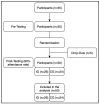DiADEM-Dance against Dementia-Effect of a Six-Month Dance Intervention on Physical Fitness in Older Adults with Mild Cognitive Impairment: A Randomized, Controlled Trial
- PMID: 39202080
- PMCID: PMC11355115
- DOI: 10.3390/jpm14080888
DiADEM-Dance against Dementia-Effect of a Six-Month Dance Intervention on Physical Fitness in Older Adults with Mild Cognitive Impairment: A Randomized, Controlled Trial
Abstract
Background: Preserving health and physical fitness is critical to ensure independent living across the lifespan. Lower levels of physical fitness are associated with age-related cognitive decline and a higher prevalence of mild cognitive impairment (MCI). Thus, this study investigates the influence of a six-month dance intervention on selected measures of physical fitness in older adults with MCI. Methods: In this randomized controlled trial, 55 patients with MCI were randomized into a sportive dance training (IG; n = 26; age: 70.7 ± 5.6 years; 62% female) or an inactive control group (CG; n = 24; age: 69.1 ± 6.8 years; 46% female). The dance group received two 90 min dance training sessions per week over a duration of six-months, which focused on learning dance movement patterns. During the training sessions, heart rate was measured to control exercise intensity. Physical fitness was assessed using cardiopulmonary exercise testing (CPET), lower limb functional fitness via sit-to-stand test, handgrip strength, and heart rate variability (HRV). Results: We observed that the dance intervention preserved the cardiorespiratory fitness as measured by maximal oxygen uptake (VO2max) during CPET, which decreased in the CG. Furthermore, participants in the IG demonstrated increases in leg and handgrip strength, although these were not statistically significant. HRV displayed a non-significant decrease following the intervention. Conclusions: The results of this randomized controlled trial suggest that sportive dance training can preserve elements of physical fitness (i.e., cardiorespiratory fitness) in older adults with MCI. Although improvements in the other parameters (i.e., leg and handgrip strength) were statistically non-significant, likely due to the small sample size, stabilizing muscular fitness and preventing age-related decline in older adults with MCI is important for maintaining functional independence. For future studies, we recommend a longer training duration paired with precise control of regular physical activity levels, an important confounding factor.
Keywords: cardiorespiratory fitness; geriatrics; physical fitness; prevention; sportive dance training.
Conflict of interest statement
The authors declare no conflict of interest.
Figures
References
-
- Stiebler M., Müller P., Bock M., Lechner B., Lechner K. Turning back the clock on aging? A perspective on selected mechanisms and therapeutic avenues. Dtsch. Z. Sportmed. 2021;72:335–343. doi: 10.5960/dzsm.2021.507. - DOI
-
- Bangsbo J., Blackwell J., Boraxbekk C.-J., Caserotti P., Dela F., Evans A.B., Jespersen A.P., Gliemann L., Kramer A.F., Lundbye-Jensen J., et al. Copenhagen Consensus statement 2019: Physical activity and ageing. Br. J. Sports Med. 2019;53:856–858. doi: 10.1136/bjsports-2018-100451. - DOI - PMC - PubMed
-
- World Health Organization . WHO Guidelines on Physical Activity and Sedentary Behaviour. World Health Organization; Geneva, Switzerland: 2020.
Grants and funding
LinkOut - more resources
Full Text Sources
Miscellaneous



